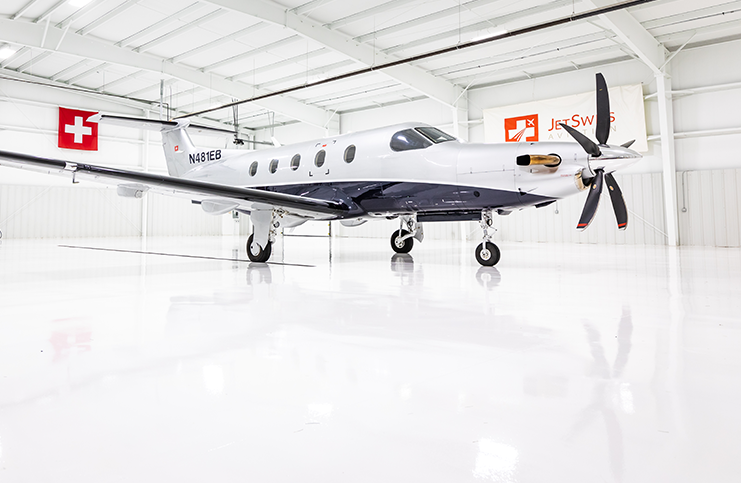
If you’re like myself and most pilots out there, we all long to go higher, faster, and fly a larger airplane. Remember that first time you got to swing the gear in an airplane that you were flying…ah yes, “check this out, I move this little lever and my landing gear goes up! Sweet.” Here’s the good news; the Pilatus seems to satisfy this urge time and time again. Well those memories only get added to and not forgotten throughout a pilot’s career. Ironically, many of the former Pilatus pilots who have moved on to fly bigger faster aircraft will all tell you “I loved flying the Pilatus, I’d go back to flying it in a heartbeat.” However, moving up the ‘food chain’ for many pilots can be determined by where skill and timing meet luck and opportunity. Have you heard this before? Let JetSwiss Aviation help while navigating the Pilatus transition.
As an example, would you be surprised to know that the Cirrus SR-22 is one of the most popular owner/pilot groups that transition into a Pilatus PC-12? Survey says: TRUE. Most folks in aviation cannot believe this! Included in this disbelief are many of the actual owners and pilots themselves. At JetSwiss we’ve accompanied several Cirrus pilots and owners over the years, each with their own unique scenario. In our experience there are several common components that helped navigate the course. By focusing on these common components initially, rather than trying to force a particular aircraft (acquisition or sale), our process and customers have greatly benefited. Keep in mind, this is not some magical recipe for aviation…
Simply put, T.O. L.I.F.T. is the common background theme for any would-be aircraft owner or pilot:
T – Training
Where do I go? What do insurance companies want? What’s the best scenario for our situation? Is there dual instruction time needed?
O – Operations
Where should I base the aircraft? How does a specific airport affect operations? Are there precision approaches at an airport? Deicing equipment? Should we build a hangar? If so, what should the hanger have?
L – Legal
Caution, we are not attorneys at JetSwiss. However, we do assist with procuring and suggesting the proper resources to structure ownership and to consider all legal aspects of owning an aircraft. Topics such as dry lease agreement, charter/leaseback agreements, renting the aircraft, management agreements, etc., and more can be in play with owning an aircraft. Obviously, there are risks, advantages, and disadvantages to every scenario, but often times it’s money well spent to have an aviation attorney in your corner.
I – Insurance
How much experience do I need, and can I get insured to fly the Pilatus? YES! We see folks with as little as 250 hours of total time get insured to fly the PC-12. Liability amounts can range from $1.0m to $5.0m in the first year, depending on experience levels. What about mentor flying? We see mentor flying ranging from 10 hours to upwards of 75-100 hours, again depending on experience levels. The key thing to remember is that flying the PC-12 is well within reasonable reach and it’s not one size fits all.
F – Finance
Typical loan terms in today’s market place are: 20% down, 15yr amortization, and 3-10 year loan term. Of course many variables and offshoots exist on the finance package, with the most flexibility being driven by excellent credit and low risk. Want less down payment? No personal guarantee? How about step down payments, or seasonal payments? All of these topics can easily be looked into with the proper professional involved. We suggest addressing this topic in the very beginning, as you’ll want to check this box for the utmost clarity.
T – Taxes
Oh yes, and don’t think taxes does not play a significant role in moving up the food chain of aircraft. When acquisition levels go north of six figures, the tax benefit of depreciating an aircraft becomes a large driving factor. Combined with legal structure, this topic definitely has its advantages and disadvantages. How can I depreciate the aircraft? What depreciation schedule will I be on? What if I use the aircraft personally? How about setting up a leasing company? Sales tax? We have the aviation tax experts that can address this very important topic.
I hope that we have helped shed light on the components that we see make a difference for navigating the Pilatus transition. So often we see several owners and pilots who forge ahead with the wrong team and the wrong playbook, only to be left standing around asking “How do I? Where is the? Can we do X? I thought we could do Y?…” Again, the T.O. L.I.F.T. topics are not ‘rocket science’ in any way. The key is to get your homework done, engage credible resources, and ‘check off the boxes’ before formulating too large of an opinion or taking hard action. Certainly transitioning into the Pilatus can be well within your reach if done properly. The good news is that it’s what we love to do at JetSwiss!
Fly safe and fly Swiss,
Don
“JetSwiss specializes in the sales, management, and operations of Pilatus aircraft. With over 18 years intimately involved with the Pilatus Factory/Dealer program, JetSwiss has the resources, knowledge, and expertise that produce positive results.
If you currently own a Pilatus or you’ve been considering a Pilatus, if have questions about Pilatus, or if you might benefit from having an expert on your team, we invite you to contact us today.”
